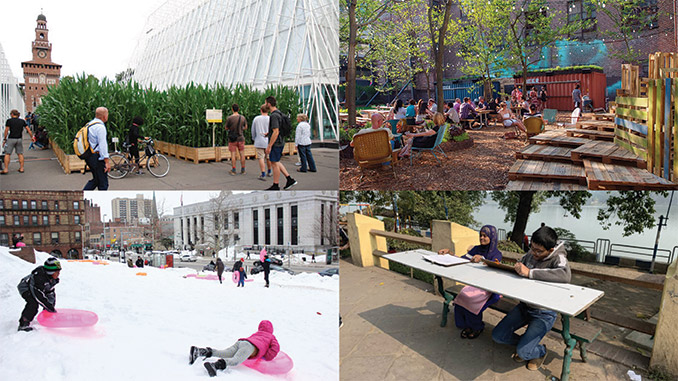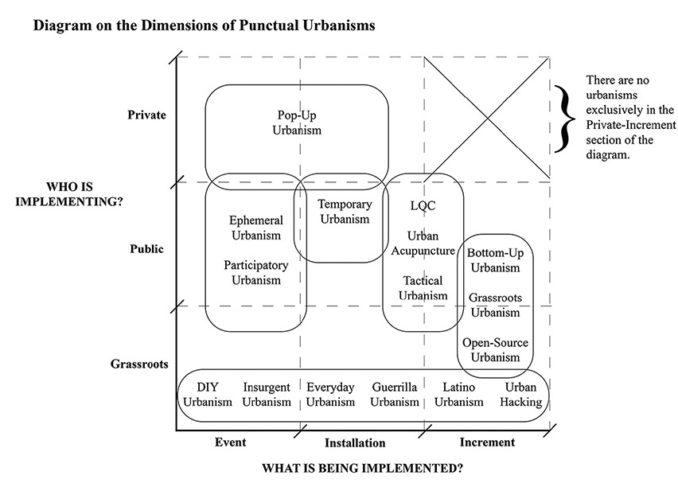
Over the years, there have been many terms to describe traditional planning projects (master planning, placemaking) and small scale interventions (tactical, pop-up, temporary); these terms often overlap. Punctual Urbanisms: Rapid Planning Responses to Urban Problems [1] – A paper by Landgrave-Serrano, Stoker, and Crisman have suggested the term punctual urbanism to create a single unifying term that captures all the various terms used for different urbanisms.
“We propose and use the overarching category “punctual urbanism” to group and understand these urbanisms. This term has been adapted from the analogous term punctual intervention (Casagrande 2020; Ellin 2013). This characterization captures the essence and substance of these urbanisms as described in the literature. First, they are punctual: they respond quickly to an urgent need that has in some way been identified through participatory means as traditional planning processes prove to be too slow and cumbersome. Second, they puncture the urban landscape in very site- and time-specific ways: they are generally small in scale, ranging from tiny interventions to larger interventions that nevertheless are imagined as sites of exception rather than adhering to master-planned and organized forms of urbanism.” [1]
When suggesting or coining new terms, there is often pushback, and adverse reaction due to people needing to change their behaviour, thought patterns and references. I have always loathed the term tactical urbanism as it sounded like something that occurred in a war firefight rather than a temporary intervention. Do we need a new term for the various types of urbanism? Punctual urbanism is an interesting term. The authors’ reasoning is urgent and punctures the landscape provides a more effective and palatable term than tactical urbanism or urban hacking. Is there a better term such as urban interventions? When assessing terms and their use, I often think about how understandable it is for the general public. As professionals, we often coin and use jargon that creates a barrier and makes the profession(s) less approachable. Does the term punctual urbanisms feel approachable and easy to understand?

Landgrave-Serrano, Stoker, and Crisman’s paper provides an excellent background to the different types of urbanism, including Latino urbanism, DIY urbanism, Light Quick and Cheap urbanism, Urban Hacking, Urban Acupuncture, and so on. What is apparent from the authors’ background is that they all have varying degrees of private and public involvement and differing scales, ideas and timelines.
The authors’ used an interrater reliability test when analysing the range of responses and urbanism terms discussed in the literature. Landgrave-Serrano, Stoker, and Crisman reviewed and classified forms of urbanism based on who is implementing the plans and the scale and temporality of the urbanisms. “The article analyzes sixteen terms used to define small-scale urban interventions. Despite certain distinguishing factors among them, the quantity of terms and their overlapping features justifies the use of a single unifying term: punctual urbanism.” [1]
In short, punctual urbanism creates a single unifying term that captures all the various terms of different urbanisms. Many people will still use various terms to differentiate the multiple urbanisms; however, punctual urbanism is useful term to utilise when discussing projects and policy with clients, governments, and communities.
Sources
[1] Landgrave-Serrano, M., Stoker, P. and Crisman, J. J. (2021) ‘Punctual Urbanisms: Rapid Planning Responses to Urban Problems’, Journal of Planning Literature, 36(4), pp. 467–491. doi: 10.1177/0885412221999424.
Cover Image Credit:
Top Right – Pop Up Beer Garden | Philadelphia USA | Groundswell Design Group – Courtesy – Groundswell Design Group
Bottom Left – White Space Cambridge | Cambridge, USA | Nina Chase, Emily Milliman, David Buckley Borden – Image Credits: Michael Peguero of Baselog; Matthew Reese;
Bottom Right – Reimaging the City: Upcycling in the public space – Image Credit: Aishwarya Tipnis
DISCLAIMER: This article is for educational purposes only. The content is intended only to provide a summary and general overview on matters of interest. It’s not intended to be comprehensive, nor to constitute advice. You should always obtain professional advice, appropriate to your own circumstances, before acting or relying on any of that content. This advice is general in nature.
